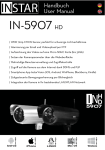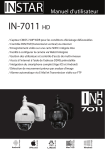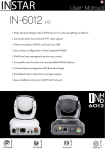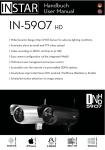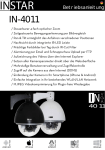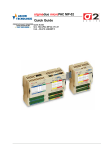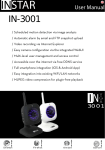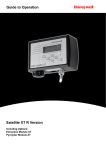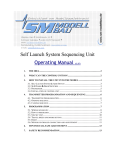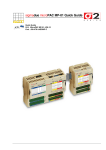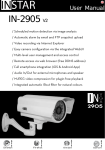Download IN-6014HD - INSTAR Deutschland!
Transcript
Handbuch User Manual IN-6014 HD / Integrated Passive Infrared Motion Detector / Wide Dynamic Range 720p CMOS Sensor for adverse lighting conditions / Automatic alarm by email and FTP video upload / Video recording on SDHC card (up to 32 GB) / Easy camera configuration via the integrated WebUI / Multi-level user managment and access control / Accessible over the internet via preinstalled DDNS address / Smartphone App InstarVision (iOS, Android, WinPhone, Blackberry, Kindle) / Scheduled motion detection via image analysis / 4mm wide-angle lens with 90º diagonal view 6014 Wide-Dynamic Range CMOS Sensor The OmniVision® WDR Sensor raises the bar in security imaging with a single-chip SOC sensor that combines 720p high-definition video with WDR in a 1/3-inch optical format. The sensor is build on a 4.3 micron OmniPixel3-HS™ pixel enabling 720p HD at unparalleled low-light sensitivity and a dynamic range in colour of 115dB - compared to the 60 dB of a regular VGA IP camera. Allowing you to capture detail-rich colour video even in high-contrast lighting conditions. The 1280x720 pixel array provides 720p HD video at 25 frames per second broadening the scope of your surveillance. INSTAR HD IP Camera – Usermanual INSTAR IN-6014 HD 1. SAFETY WARNINGS........................................................................3-EN 2. PRODUCT FEATURES.......................................................................4-EN 3. INSTALLATION...................................................................................5-EN 4. START UP.............................................................................................8-EN 5. THE WEB USER INTERFACE.........................................................11-EN 5.1 SOFTWARE..........................................................................................12-EN 5.1.1 LANGUAGE........................................................................................12-EN 5.1.2 REBOOT/RESET.................................................................................12-EN 5.1.3 BACKUP..............................................................................................12-EN 5.1.4 UPDATE..............................................................................................12-EN 5.2 NETWORK............................................................................................13-EN 5.2.1 IP CONFIGURATION........................................................................13-EN 5.2.2 WiFi ....................................................................................................13-EN 5.2.3 DDNS..................................................................................................14-EN 5.2.4 P2P (Point-to-Point)............................................................................15-EN 5.2.5 UPnP....................................................................................................15-EN 5.3 SYSTEM.................................................................................................16-EN 5.3.1 INFO....................................................................................................16-EN 5.3.2 DATE & TIME.....................................................................................16-EN 5.3.3 USER...................................................................................................16-EN 5.3.4 STATUS LED.......................................................................................16-EN 5.3.5 IR LED.................................................................................................17-EN 5.3.6 ONVIF.................................................................................................17-EN 5.3.7 PTZ.....................................................................................................17-EN 5.3.8 SYSTEM LOG......................................................................................17-EN 5.4 MULTIMEDIA.......................................................................................17-EN 5.4.1 AUDIO.................................................................................................17-EN 5.4.2 VIDEO.................................................................................................18-EN 5.4.3 IMAGE.................................................................................................18-EN 5.5 ALARM..................................................................................................18-EN 5.5.1 AREAS.................................................................................................18-EN 5.5.2 ACTIONS.............................................................................................19-EN 5.5.3 SCHEDULE.........................................................................................20-EN 5.5.4 SMTP SERVER....................................................................................20-EN 1-EN 5.5.5 EMAIL.................................................................................................20-EN 5.5.6 FTP......................................................................................................21-EN 5.5.7 PHOTO SERIES...................................................................................21-EN 5.5.8 SD CARD.............................................................................................22-EN 5.6 RECORDING ........................................................................................22-EN 5.6.1 SCHEDULE..........................................................................................22-EN 5.6.2 VIDEO..................................................................................................22-EN 5.6.3 PHOTO SERIES.....................................................................................22-EN 5.7 MENU BAR............................................................................................23-EN 5.7.1 SD CARD.............................................................................................23-EN 5.7.2 SNAPSHOT..........................................................................................23-EN 5.7.3 RECORD (only Internet Explorer)........................................................23-EN 5.7.4 PLAYER (only Internet Explorer)..........................................................23-EN 5.7.5 HELP....................................................................................................23-EN 5.7.6 MJPEG (h.264).....................................................................................23-EN 5.7.7 ALARM................................................................................................23-EN 5.8 VIDEO MENU BAR................................................................................24-EN 5.8.1 AUDIO (only Internet Explorer)...........................................................24-EN 5.8.2 MICROPHONE (only Internet Explorer).............................................24-EN 5.8.3 DIGITAL ZOOM (only Internet Explorer)...........................................24-EN 5.8.4 RECORD PATH (only Internet Explorer).............................................24-EN 5.9 PAN&TILT CONTROL............................................................................24-EN 5.9.1 CONTROL PAD..................................................................................24-EN 5.9.2 POSITIONS.........................................................................................25-EN 5.10 WEB USERINTERFACE UPDATE.......................................................25-EN 6. RESET YOUR CAMERA..........................................................................25-EN 7. LENSE ADJUSTMENT.............................................................................26-EN 8. ANDROID AND iPHONE APP.............................................................26-EN 9. WINDOWS SOFTWARE.........................................................................28-EN 10. RTSP STREAMING.................................................................................30-EN 11. TECHNICAL DATA..................................................................................31-EN 12. WARRANTY & DISPOSAL....................................................................32-EN 13. FAQ Questions & Answers......................................................................33-EN 14. AVAILABLE ACCESSORIES..................................................................35-EN More user manuals can also be found on download.instar.de Your Manufacturer for Network and Security Technology 2-EN 1 l SAFETY WARNINGS Please read the following safety warnings carefully and keep them in a safe place. » Make sure the power cord is not near any hot surfaces. » Place the Power and Network cable properly so that no one can be hurt. » This device shall not be used by people (including children) with limited physical, sensory and mental capabilities. Only the trained person that knows how to use the device carefully can use the device. » Children should be supervised to make sure they don’t play with the device. » If the power cord of this device gets damaged, it can only be replaced by the manufacturer or the customer service person or a similar qualified person to avoid any damage to you and the device. » Never do any repair by yourself. By opening the device the warranty will automatically expire. If any repair is needed, please contact your INSTAR Service Center. » When cleaning, please never place the device in water. » Make sure you only install the device in a 100V - 240V power socket. » This device is only suitable for indoor use. » Only use this device to secure your home, office and similar places. If you are planning to install the device in an public area please make sure you have all certificates to do so. » Never install the device near explosive or flammable substances. » Don’t use the camera for any other purpose that it isn’t made for. » INSTAR does not give any warranty if you use any third party firmware or WebUI. » Please note that this is an indoor camera which is made for indoor surveillance only. CE-Conformity This device suites the basic requirements of the European regulations for electromagnetic compliance (2004/108/EC) and the low voltage regulations (2006/95/EC ). 3-EN 2 l PRODUCT FEATURES Hardware » Integrated passive Infrared Motion Detector » Wide Dynamic Range Megapixel CMOS sensor and ARM media processor » 12 Infrared-LEDs for nightvision 8 - 12 m » Resolution: 720p (1280 x 720), 640 x 352 and 320 x 176 » Exchangeable wide angle lense with a 90º diagonal field of view » Automatic IRcut filter for realistic colours during the day » Integrated SDHC card slot for microSD cards up to 32 GB » Pan&Tilt: 350 º horizontal and 100 º vertical Connectivity » 10/100Mbit ethernet interface to connect to your router or PC » WLAN compatible - 2.4 GHz Wi-Fi 802.11b/g/n » Remote access your live video with your smartphone (iOS, WinPhone8 & Android) Software » h.264 video encoding for reduced bandwidth requirements » Video and snapshot recording on SD card is supported » Video recording by alarm and FTP upload (only with SD card) » Software based motion detection by image analysis / Alarm notification by email » Email and FTP snapshot upload - continuous and alarm triggered 4-EN 3 l INSTALLATION 1 2 3 4 7 8 9 10 11 12 5 6 13 Fig. 1 Front 14 Fig. 2 Rear 15 Fig. 3 Bottom 1 Photosensor Twilight-Switch for IR LEDs 2 Lense Wideangle-lense (focal length: 4.3mm / field of view: 90.º hor.) 3 Infrared-LEDs 12 IR LEDs (nightvision @ 850nm) 4 PIR Detector Integrated passive Infrared Motion Detector 5 Loudspeaker Integrated Loudspeaker (s. 5.7.2) 6 Microphone Audio transmission (s. 5.7.2) 7 Power Connector 5V / 1.5 A DC - Plug Ø : 1.35mm (in) / 3.5mm (out) 8 LED Indicator Red: power LED; blue: Status-LED for network traffic 9 Reset Button (also WPS Button) Reset camera to the factory default setting by pressing 15 seconds. (WPS function: press 3 seconds to connect with Wifi Router) 10 MicroSD Card Slot Slot for SD/SDHC cards up to 32 GB (4 GB included) 11 Antenna Connector SMA WiFi antenna connector 12 Network Port RJ45 LAN-port for the provided CAT5e LAN cable 13 Audio Out 3.5mm earphone / active speaker jack 14 Camera ID MAC address LAN and QR for the P2P connection 15 Stand Mount Standard camera thread for provided stand support 5-EN Connect the camera to your Network Take out the package content from the box: the camera, a CAT5e LAN cable, a 2.4 dBi SMA WiFi antenna, mounting bracket and the software CD. Connect the WiFi antenna to the antenna connector at the back of camera, align it vertically to your router and place the camera close to your Wifi router for the rest of the installation process. Please be aware that the camera has to be installed via LAN cable first before it can be used in your wireless network - for an alternative network connection, please refer to the included flyer Plug&Play for a WPS integration. Plug one end of ethernet cable to the RJ45 LAN port on the camera housing and the other end to a free LAN port of your network router. For a direct connection to your Windows PC or Mac, please refer to our online FAQ section on faq.instar.de. But we recommend to connect the camera to your network router for the initial installation. Connect the power adapter to the camera cable and plug it into a suitable power outlet. Both network indicator LEDs on the network port will light up showing that the camera is connected to your network.The camera will now execute a pan&tilt calibration. The orange LED of the LAN port signals a hardware link to your router and therefore should be on continuously. The green LED should be flashing irregularly indicating network traffic. The green status LED on the power supply has to be on continuously indicating a steady power supply. Please plug the power supply directly into a wall socket. Using it on a multi-power strip or an extension cord is not recommended. 6-EN Troubleshooting The status LED of the LAN port isn’t on Your camera doesn’t have a connection to your router because the LAN cable is damaged, the connector is loose or your camera is connected to a wrong port on your router or switch. The status LED of the LAN port goes on and off every x seconds Your camera is continously restarting - possibly because of a loose contact. Please check the power connector on the camera side. Turn the plug by 180 degrees in both direction and check if the problem persists. Make sure the green status LED on the power supply is on continuously. For a direct cable connection between camera and computer, please note: The network cable provided with the camera is not a crossover cable. It is just a normal patch cable. Most modern computers network interfaces support the automatic switching between crossover and normal patch cable - you can use the cable that came with the camera to connect it directly. If you are using an older system to connect your camera directly you might need a crossover network cable. To set up the camera for the first installation, we recommend to connect the camera directly to your router. This router on the other side has to be connected with your computer. Other ways of connections are only recommended for experienced users. Please refer to our online documentation on http://faq.instar.de. Connect the camera using an IN-LAN® Adapter (optional) Simply plug one IN-LAN adapter into a power socket next to your broadband router and connect the adapter to your router via an Ethernet cable. Plug the second IN-LAN unit into an outlet close to your INSTAR camera and connect the camera to the IN-LAN adapter using the camera’s Ethernet cable. IN-LAN 500/p Powerline Adapter IN-LAN uses the household power grid to transfer data between computers equipped with suitable adapters and other network components. As a result, any power outlet can be used as a network access point. IN-LAN is an intelligent and secure technology that lets you set up a home network easily via your household power grid - without the need of complex and expensive dedicated cabling. Additional accessories, like the IN-LAN Adapter, can be found in the accessories of your camera model on www.instar.de. 7-EN 4 l START UP To install your camera please open the installation CD or simply go to http://install.instar.de. Please follow each step for an easy first setup of your camera. To find the camera in your network we provide you with a free Windows, MacOS and Linux tool that allows you to find, update and open your camera on your computer. As an alternative you can also use an IP scanner or check inside your router to find out the ip address of your new ip camera. 4.1 l NETWORK INSTALLATION Please start the setup wizard from the CD and install the INSTAR Camera Tool linked on the CD for Windows, LINUX or MacOS. (You can find documentations for the use of other IP scanners on http://faq.instar.de) Please start the INSTAR Camera Tool. The camera tool will automatically find all INSTAR IP cameras in your network and will show their IP address. In case your camera isn’t found right away please wait 10 to 15 seconds for your routers DHCP service to assign an IP address to your camera. Double-click the camera’s IP address inside the camera tool to open the web user interface (webUI) with your default browser and you will be greeted by the camera’s login window. If so, please skip the following paragraph and go straight to 4.2 LOGIN (see page 11). 8-EN Troubleshooting: In case the INSTAR Camera Tool doesn’t find your INSTAR IP camera please make sure that the status LED for the LAN connector is active. For troubleshooting please check on page 8 in this user manual. In case your camera isn’t automatically assigned an IP address, the camera will be shown inside a wrong IP address space. A double click on the camera’s IP will then open the IP / Network configuration window (see below) allowing to manually assign an address. Please set the following information according to your network: - IP Address (for example 192.168.x.x) - Subnet Mask (for example 255.255.255.0) - Gateway (IP Address of your router; for example 192.168.x.1) - DNS Server (IP Address of your router; for example 192.168.x.1) - Http Port (TCP Port; for example 80) To check the IP address of your Windows computer and your network parameters please do the following: 1. 2. 3. Click on [START] -> and type in “cmd” into the search field. In the window that pops up please type “ipconfig”. Now the IP address and the subnet mask will be shown. 9-EN EXAMPLE: If your gateway is “192.168.178.1”, please fill in the camera information accordingly: - IP Address of the Camera: 192.168.178.190. (“190” is just an example) - Subnet Mask: 255.255.255.0 - Gateway: 192.168.178.1 - DNS Server: 192.168.178.1 - Http Port: 80 (default port, can be changed) How to setup your camera without a router: If you want to connect your camera directly to your computer, please set a fixed IP address for the network interface in your computer, as well as for the IP camera. You can set the camera IP by using the INSTAR Camera Tool. As for Gateway and DNS server please fill in the computer IP. After submitting the settings to the camera please wait a moment until the camera has restarted. For a detailed instruction please refer to our FAQ section on http://faq.instar.de 4.2 l LOGIN For the first installation of the camera please log in with the following username and password: user: password: admin instar 4.3 l PLUGIN INSTALLATION (only Internet Explorer) 4.3.1 After the login (Internet Explorer) you will be asked to install the ActiveX control element. Please run it and confirm when your Internet Explorer is asking you to install the control element: 10-EN After the installation, please restart your Internet Explorer, a window will pop up as below. Please press “Allow” to run the ActiveX control element in your web browser: 4.3.2 Accessing with other browsers (Firefox, Chrome, Safari,...) In order to access the live video stream through other web browsers, please install the Quicktime Player. Please follow the enclosed A5 Quick Installation manual. Also check the FAQ section at the end of this user manual (chapter 13) or visit the FAQ section on http://wiki.instar.de for more detailed instructions. 5 l THE WEB USER INTERFACE 11-EN 5.1 l SOFTWARE 5.1.1 SOFTWARE/LANGUAGE Here you can choose the language of the web user interface. The web user interface will reload after you click submit. 5.1.2 SOFTWARE/REBOOT-RESET Here you can check the user interface and firmware versions. To restart or reset your camera simply check the corresponding box and click submit. To avoid an unwanted reset, a remark will be show in a new window and you need to confirm the command a second time after a 10 seconds countdown. 5.1.3 SOFTWARE/BACKUP To save your camera settings please check the corresponding box and click submit and you will be asked for a file path and name. The default is config_backup.bin and the file path is the download folder of your browser. To restore the settings check “Load Backup Copy”, browse for the backup file and click submit. 5.1.4 SOFTWARE/UPDATE You can download regular software updates for your camera from http://download.instar.de. Please use the browse button to set the file path to the downloaded *.PKG file and click “Submit” to upload the file to your camera. Use the update function only when the camera is connected to the router by LAN cable! 12-EN 5.2 l NETWORK 5.2.1 NETWORK/IP CONFIGURATION You can set whether the camera will be assigned an IP address by your router (DHCP) or you want to manually set a fixed address. Please check page 9 &10 on how to set a fixed IP address. In general, we recommend that you deactivate the automatic service and set a manual IP to avoid further trouble with the remote access to your camera. For the RTSP Port please refer to 10. RTSP Streaming for details on the use of the camera´s RTSP videostream. 5.2.2 NETWORK/WiFi (not applicable for PoE Model) If you cannot use the WPS service (Wireless Portected Setup) to integrate the camera into you local WiFi network see included flyer Plug & Play for further information for the WPS function - click search to start the WLAN scanner. Just choose your own network and click “Join”. Now you simply have to add the WiFi password (WLAN Key) and click submit to save the settings. Afterwards you can use the Test function to verify your settings. Please disconnect the LAN cable and wait about 30-60 seconds for the camera to connect to your WiFi network. The camera will receive a new address from your router if you didn’t assign a static IP address to your camera previously (Chapter. 5.2.1), therefore you should use the INSTAR Camera Tool again to rediscover your camera (Chapter 4). Attention: Your WiFi modules MAC address is not identical with the LAN MAC address of your camera! If you are using a MAC filtering rule for your WiFi network, please deactivate the filter and add your camera to the list of trusted devices before reactivating it. Additional Remark: Your camera supports a range of encryption standards - we recommend for the safety and reliability of your connection - that you set your WiFi network to WPA2 (PSK) with AES (or CCMP). With older routers choose WPA (PSK) / AES. Avoid using a mixed mode like WPA&WPA2 - TKIP! If your WiFi stays unstable please choose a fixed WiFi channel for your router - we recommend the channels 1 - 6. 13-EN 5.2.3 NETWORK/DDNS Your camera comes with a personal DDNS address e.g. http://xxxx77.ddns-instar.de. Everything you need for a remote access to your camera is a port forwarding rule in your router. You can access your camera afterwards through the internet using this http address. Please refer to FAQ Chapter #13. 4) for port forwarding or visit our online FAQ section on http://faq.instar.de for detailed information on the port forwarding setup as well as video instruction for many common routers. Or refer to your router’s user manual for further guidelines on how to set up a port forwarding rule. EXAMPLE Portforwarding - Netgear: Please refer to our online help http://faq.instar.de for detailed instructions for all commen routers. In case you want to use an account from DynDNS.org simply choose the third party service and type in your personal login credentials. By doing so you will temporarily deactivate your INSTAR DDNS address. If you are using several cameras behind a single internet access point, please set up the third party address in only one of the cameras. Or if possible directly inside your router! All your cameras will be accessible through this address - just assign a unique HTTP port to every camera (s. 5.2.1). For example if camera 1 is assigned the HTTP port 85 and camera 2 the HTTP port 86, use myaddress.dyndns.org:85 to reach camera 1 and myaddresse.dyndns.org:86 to be forwarded to camera 2.(more details please see FAQ) 14-EN 5.2.4 NETWORK/P2P (Point-to-Point) Activate the P2P function to access your camera from the internet without the need for a port forwarding in your router (s. 5.2.3). Simply add the camera as a P2P camera in our InstarVision app (s. 8), scan the QR code on the Network/P2P overlay in the webUI or from the label on the camera and add the cameras administrator login (s. 4.2). You can access your camera even behind an IPv6 connection or mobile Router (UMTS/LTE, with changing WAN IP)! Use the P2P function to access your camera from the internet, when you cannot set a port forwarding for the camera that is necessary for the DDNS service (s. 5.2.3). 1 2 Manually type in your User ID or... 3 ...use the automatic network or QR scanner. QR Code There are 3 ways to connect your camera with the INSTAR App 1 Tap the “Search” button to find the p2p camera inside your local network 2 Type in the “UID” from the camera´s web UI or from the label on the camera case. 3 Click QR Scan and use your smartphone to scan the QR code on the webUI or on the label that you can find on the camera casing. Please note that the QR code in the webUI and on the product label both contain the UID, camera model, admin username and password for a quick setup. Please note that the username and password on the product label are only default settings (s.4.2), while the webUI QR code will be always up-to-date with the log-in credentials. We recommend that you change the administrator password of the camera (s. 5.3.3) and use the QR code from the webUI. Please restart the camera after changing the password. ATTENTION: The P2P connection ONLY works with the admin user! 5.2.5 NETWORK/UPnP If you are using Universal Plug and Play(UPnP) for your network devices, please activate the UPnP service in your camera. In case you are using a manual port forwarding rule in your router to access your camera from the internet, make sure the cameras UPnP service is deactivated! We recommend setting up a manual port forwarding. 15-EN 5.3 l SYSTEM 5.3.1 SYSTEM/INFO The Info menu gives you an overview of several important camera parameters - like your software version and connection status. 5.3.2 SYSTEM/DATE & TIME You can set up the internal clock of the camera to be either synchronised with your PC clock or with one of several NTP servers. As long as your camera has access to the internet it is recommended to use an NTP server synchronisation to achieve a higher accuracy for alarm trigger events. Please activate “Consider Daylight Saving Time” when in effect. 5.3.3 SYSTEM/USER The web user interface offers a 3-level user management with different access rights for administrators, operators and visitors. You can set user names and passwords for all three user levels in the Users mask. Guests will only have access to the videostream of the camera, Userss in addition are able to use the pan&tilt function and only the Administrator will have access to all the camera’s configuration menus. 5.3.4 SYSTEM/Status LED Here you can adjust the behaviour of the network status LED. You can turn off the blue status LED (which can be found at the back of the camera) or you can turn it on in order to signal if there is a network connection or not. 16-EN 5.3.5 SYSTEM/IR LED Here you can activate or deactivate the infrared LED on the camera. Please note if you deactivate the infrared LED, the nightvision of the camera will be gone. 5.3.6 SYSTEM/ONVIF ONVIF is a global standard for the interface of IPbased security products. The ONVIF specification will ensure interoperability between products regardless of manufacturer, allowing you to integrate your INSTAR camera as a generic ONVIF camera into existing security systems. 5.3.7 SYSTEM/PTZ ONVIF is a global standard for the interface of IPbased security products. The ONVIF specification will ensure interoperability between products regardless of manufacturer, allowing you to integrate your INSTAR camera as a generic ONVIF camera into existing security systems. 5.3.8 SYSTEM/SYSTEM LOG The System log shows general notifications for the state of the cameras operating system . 5.4 l MULTIMEDIA 5.4.1 MULTIMEDIA/AUDIO Here you can adjust the volume of the cameras integrated microphone and speaker. 17-EN 5.4.2 MULTIMEDIA/VIDEO The video settings allow you to adjust the quality of all 3 videostreams of your camera. Please be adviced that high quality settings come with high requirements for your computer hardware and network bandwidth. Adjust the video quality to obtain a fluent video accordingly. Please refer to chapter 10: RTSP Streaming for accessing the cameras streams 2 and 3. The MJPEG mode of the camera allows you to access the videostream with your browser without the need of additional browser-plugins! You can use the MJPEG mode when you are accessing the camera from a system that doesn’t allow you to install the ActiveX control element or the QuickTime plugin for Firefox, Chrome or Safari. Please consider that this mode is only for viewing the live image of your camera. Even with only one user logged in your cameras framerate might drop below 4 fps because of the high bandwidth requirements! 5.4.3 MULTIMEDIA/IMAGE Here you can adjust the image parameters brightness, saturation, contrast, exposure (shutter) and sharpness. You can flip and mirror the video image, can display a timestamp and set a camera name and display it as well. The displayed parameters are burnt into the camera image. Please make sure to restart the camera after changing the name. 5.5 l ALARM 5.5.1 ALARM/AREAS Your camera detects motion by a picture analysis that is sensitive to every change inside the video frame instead of employing an infrared or microwave sensor. In “Areas” you can adjust up to 4 detection areas in size and sensitivity for trigger event. Once the motion detection in an area is activated, its sensitivity can be adjusted from very insensitive (value=0) to very sensitive (value=100). 18-EN In case the camera’s position is prone to rapid light changes, e.g. changes in sun intensity due to cloud movements, you might be confronted with a high number of false alarms. In this case please refer to 5.5.2 for employing external PIR motion detection sensors. 5.5.2 ALARM/ACTIONS Adjust the cameras behaviour in case of a motion alert trigger event. You can set the camera to send you an email and to save snapshots or videos on your SD card. Please make sure you set your SMTP server settings before activating the email notification (s. 5.5.4 & 5.5.5) and that you have a SD card in your cameras SDHC card slot (max. 32 GB) to use the video recording and send-to-FTP function (s. 5.5.6) - a 48 GB SD card is included in the delivery. For For video video as as well well as as picture picture recordings recordings the the camera camera will will create create aa folder folder on on your your SD SD card card with the the date date of of the the current current day. day. If If the the SD SD card card is is full, full, the the oldest oldest day/folder day/folder will will automatiautomatiwith cally all recordings recordings in in this this folder. folder. The The bigger bigger your your MicroSD MicroSD card card is, is, cally be be deleted deleted and and with withitit all which you install in the camera, the more days (recordings) you can save on the SD card. which you install in the camera, the more days (recordings) you can save on the SD card. The camera camera automatically automatically records records videos videos with with aa length length of of 15 15 seconds. seconds. Since Since the the camera camera The also also supports supports prerecording, prerecording, 2-3 2-3 seconds seconds will will be be added added to to the the recording. recording. This This way way you you will will be be able able to to see see 2-3 2-3 “before” “before” the the actual actual alarm alarm event event is is happening. happening. You can use a motion detector like the IN-Motion 500 You could reduce the video resolution in order to be able to store more recordings on the (outdoor) to improve theavailable. detection your camstorage card. Therefore we offer 3 video resolutions Therate HD of resolution with era.asSimply thewith sensor to the alarm input and 1280x720 resolution as well the VGAconnect resolutions 640x352 and 320x175 pixel. activate the external input. An alarm will be triggered The IN-6014 HD gives you advanced PIR detection technology integrated PIR once the circuit (pins 3&4 - see pagewith 5) isanbroken by the sensor at the camera front. This sensor rotates along with the camera to detetct motion relay inside the detector (n.c. “Normally Closed”) or if infront of the camera. By “external input” The in Actions underhave Alarm theactivating wire is disconnected. state you to category choose in the webUI, the camera combines the motion detection software function and the PIR depends on your sensor - the wrong choice will give a sensor for monitoring motion and trigger alarm events. in other words, only when both alert detects once the detector connected. Please motion detection featurecontinous and PIR sensor a motion, willisthe camera trigger an to the Motion Detector userrains, manual. alarm event and send therefer notification to the user. Therefore, moving treeleaves, small bugs appearing in front of the camera which usually cause false alarms will be The external connectsoftothe a relay insidePIR thesensor. camera bethat switched avoided due tooutput the application integrated Butthat be can aware it also might eliminate a few positive alerts - use with caution. manually or automatically in case ofthis an function alarm event. Please check Activate External Output to let the camera open or close a circuit with an external device connected to the pins 1&2 (s. page 5). The external output can be used with the cameras motion detection to activate signaling devices like sirens or LED lights. It can also be used to control connected devices manually, e.g. via our smartphone app. The relay can be connected to circuits with up to 60 V direct current / 125 V alternating current and max. 1 A. 19-EN 5.5.3 ALARM/SCHEDULE Here you can define a time schedule in which the motion detection, that was set in 5.5.1 and 5.5.2, should be active. Every blue square represents 30 minutes of motion detection. Please make sure to set the correct time zone in 5.3.2 as it will be used by the camera. 5.5.4 ALARM/SMTP SERVER You have to fill in your SMTP login credentials of your personal email account to enable your camera to send you a notification email in an alarm trigger event. Simply use the same login information that you use for email clients like Microsoft Outlook or Mozilla Thunderbird. The SMTP user name and password are the same that you use to login to your email account. Please check your email provider’s homepage for the SMTP server address, server port and encryption: Gmail - smtp.googlemail.com (SSL; Port 465 or 587) GMX - mail.gmx.net (SSL; Port 25, 587 or 465) T-Online - smtpmail.t-online.de (Port 587 or 25) bluewin.ch - smtpauth.bluewin.ch (Port 587) Strato - smtp.strato.de (Port 25) The camera will use this email address to send you alarm notification. You can set the email recipient under 5.5.5. 5.5.5 ALARM/EMAIL Here you need to input the sender, the receivers, the subject as well as optional a short email text of maximum 64 characters. The sender address should be in accordance with the SMTP server data (s.5.5.4), though some email provider let you choose this field freely. If you want to send the email to more than one address, simply separate the addresses with a semicolon ‘;’. E.g. [email protected];[email protected] 20-EN 5.5.6 ALARM/FTP After activating the FTP upload function (s.5.5.2 Actions), you have to set your ftp server address and login credentials. You can for example use your routers FTP service as FTP Server - in this case simply put in your router’s IP as the FTP Server address. If you set up a FTP server on a local PC (for example with Filezilla Server), use the PC’s local IP address. Of course you can use a webservers URL’s as well. The standard FTP port is 21. You can define an upload directory for your camera under FTP Folder. The root folder of the FTP server can be reached by “./”. The separator for the folders is the forward slash. A subfolder (e.g. INSTAR) can be reached by “./INSTAR”. An ending forward slash is not obligatory, but can be used. The FTP Username and FTP Password are the login credentials for your FTP account. For the FTP Mode you can choose between a passive (PASV) and an active mode (PORT). The default is the active PORT mode. If your server is installed behind a router with an active network address translation (NAT), or if a firewall is blocking the server’s network from an external access by your camera, you should choose the PASV mode. The name of the video file is fixed and corresponds to the following syntax: rec011_ YYYYMMDDhhmmss.asf. The first part show the channel 11 for recording. Separated by an underscore it shows the timestamp, which marks the time of the motion detection. Please refer to our website for information on how to set up a FTP server. 5.5.7 ALARM/AUDIO ALARM The camera can also detect loud noises and cause an alarm. Therefore, simply enable the audio alarm and set the sensitivity for the volume that needs to be reached in order to trigger an alarm. 1 = not sensitive 10 = very sensitive 21-EN 5.5.8 ALARM/SD CARD Please check the corresponding box and click submit to either format or unmount your SD card. A click on the link above the submit button will lead you to the SD card directory where all your snapshots and videos will be stored. Use your camera admin login to access the directory. 5.6 l RECORDING 5.6.1 RECORDING/SCHEDULE Here you can set the schedule for the photo series as well as for the continual video recording to SD card. Every blue box represents 30min of activity. The recorded files will be stored to the camera’s internal SD card. The file name will start with a capital “P” to differentiate them from alarm recordings “A” and test images that start with a “T”. 5.6.2 RECORDING/VIDEO In this menu you can activate the continuous video recording to SD card. Here, you can set the video lengths and video resolution. The max. time per file is 15 minutes. For this function we recommend you to use a larger size MicroSD card (max. 32GB) in order to prevent the card from being overwritten too soon. 5.6.3 RECORDING/PHOTO SERIES Here you can activate the recording of a snapshot series in a selectable span of time. The snapshots will be saved to a SD card which has to be in the camera’s SDHC slot (a 1 GB SD card is included in the delivery). The JPG snapshot can later be accessed via the web user interface (s. 5.7.1). For FTP upload, if you do not set a fixed name, then the file name will be set according to this format: PYYMMDDhhmmss00.jpg. 22-EN 5.7 l MENU BAR 5.7.1 MENU BAR/SD CARD Click on the SD Card to open the SD card’s directory in a new browser window or tab - all your snapshots and videos will be listed. Use your camera admin login to access the directory. 5.7.2 MENU BAR/SNAPSHOT Click on Snapshot to save a single JPG snapshot of the current video frame. For Internet Explorer, the snapshot will be saved locally in the subfolder Snap under the record path that is set in 5.8.4 (only Internet Explorer). Otherwise the snapshot will be opened in a new browser window or tab and can be saved from there. You might have to set the cameras address (local IP or DDNS address) as a trusted site inside the Internet Options of your Internet Explorer to allow write access to your harddisk! 5.7.3 MENU BAR/RECORD (only Internet Explorer) Click on Record to manually start a video recording. The video will be saved in the subfolder “Record” under the record path that is set in 5.8.4. You will see the red indicator in the video menu when the camera is recording. You might have to set the camera’s address (local IP or DDNS address) as a trusted site inside the Internet Options of your Internet Explorer to be give write access to your hard disk! 5.7.4 MENU BAR/PLAYER (only Internet Explorer) By clicking on Player you can start a simple video player to play your recorded video files. 5.7.5 MENU BAR/HELP Clicking on Help will bring you to our constantly expanding online FAQ section on www.instar.de. 5.7.6 MENU BAR/MJPEG (H.264) Here you can switch between the camera’s H.264 and MJPEG videostream - see also 5.4.2. If you are using the IE web browser, the function Record and Player is only supported in the H.264 mode. 5.7.7 MENU BAR/ALARM Clicking on Alarm activates or deactivates the alarm settings (s. 5.5.1). If the motion detection is armed the letters will be displayed in red. 23-EN 5.8 l VIDEO MENU BAR 5.8.1 VIDEO MENU BAR/AUDIO (only Internet Explorer) Click here to activate the camera’s integrated microphone or speaker. You can adjust the volume of the audio signal under 5.4.1. 5.8.2 VIDEO MENU BAR/MICROPHONE (only Internet Explorer) In case your PC is equipped with a microphone, click here to activate the audio-out of your camera. 5.8.3 VIDEO MENU BAR/DIGITAL ZOOM (only Internet Explorer) Click here to adjust the cameras 3 x digital zoom. 5.8.4 VIDEO MENU BAR/RECORD PATH (only Internet Explorer) Here you can set the record path for your videos and snapshots. The set path is used by all your INSTAR Megapixel Cameras! Your camera will automatically create subdirectories with the current date and its IP address when you start recording or take a snapshot. All snapshots will be saved in the subdirectory “Snap” and all videos in the subdirectory “Record”. Note that you have to add the cameras IP or DDNS address to the trusted sites in your web browser. 5.9 l PAN / TILT CONTROL 5.9.1 PAN&TILT CONTROL/CONTROL PAD You can use the control pad to pan and tilt your camera´s head. You can also start a horizontal (hscan) or vertical (vscan) patrol or stop the cameras movement (stop). The camera will move in both patrols into the according terminal positions and then go back to the initial position. If you are using the Internet Explorer you can also click into the boundary areas of the video frame to move the camera into the respective direction and double-clicking the center of the frame will get you into a full screen mode. 24-EN 5.9.2 PAN&TILT CONTROL/POSITIONS You can save up to 8 camera orientations by moving the camera into the desired direction and clicking on one of the numbered slots after choosing Save Position. Clicking on the slots 1-8 when Go to Position is activated will move the camera back to the saved position. You can delete all positions by clicking on Reset all Positions. Position 1 defines the startup position of your camera! 5.9 l WEB USER INTERFACE UPDATE How to upgrade to a new WebUI or Firmware Please download the newest version of the WebUI or Firmware from our website. Please follow the link below to our homepage´s download section: http://download.instar.de Simply select your camera model, scroll to the bottom part of the website and choose the newest Software/Firmware for your IP camera. The firmware file can be uploaded to your camera via the web user interface (s.5.1.4) or by using the INSTAR camera tool. 6 l RESET YOUR CAMERA In order to reset your camera (if you have lost your password), please hold the small camera reset button for min. 15 seconds. Make sure the camera is connected to the power supply. If a reset was incomplete the camera might become inresponsive. Please repeat the reset for min. 15 s and unplug the camera over night from the power supply before trying to restart it again. 25-EN 7 l LENSE ADJUSTMENT The IN-6014 HD’s lense offers a limited field depth that was adjusted to a field between 1m to 10m. In case the object you want to observe lies outside of this area, you will have to adjust the lense accordingly. Fig. 1 Fig. 2 Fig. 3 Fig. 4 Fig. 2 Fig. 1 Fig. 1/2 Connect the camera to the powersupply and the network cable. Open the web interface and turn the lense until you can see a clear and sharp picture. 8 l Android, WinPhone and iOS App To integrate your IP camera in the App “InstarVision” we recommend to first download the newest version in the App Store. To find the newest version just type “instar” for the search. (Fig. 1) After installing the newest version please start the app to open the following interface (s. next page). (Fig. 2) Now press the “New camera” button and type in all necessary data for your IP camera. (Fig. 3) Adjust your camera’s parameters over the apps user interface. (Fig. 4) Press a channel to access the corresponding livestream and take control over your camera. 26-EN Fig. 1 Fig. 2 Fig. 3 Fig. 4 Here you find a short overview of all necessary settings (Fig.2): Name: Please choose a name for each camera so you can differenciate between your cameras. Host/IP Address: Here you have to type in the IP address of the camera or the DDNS address (see 5.2.3). Port: Type in the HTTP Port which you assigned to your IP camera. The standard Port is “80”. Username: The username with which you log in to your camera. The admin account name is “admin”. Password: The password with which you log in to your camera. As default the password is “instar”. Model: Please choose your INSTAR camera model. Now please choose “Save” to save the settings and to return to the home screen (Fig.1). 27-EN 9 l WINDOWS SOFTWARE sold separately InstarVision® is a 16/32 Channel Video Surveillance Software for Windows (the number of available channels depends on your license!) The Software can record the live stream of any Webcam, TV Cards, Video-Recording Cards (DVR), INSTAR IP Camera or other devices with up to 30 fps. InstarVision® covers below features: 1). Advanced motion detection algorithm with a mask matrix – free adaption of the motion detection mask with a 64 square resolution inside the picture. 2). Multiple ways of notification are available in case of an alarm - by email, FTP upload, acoustic alarm or by 3rd party software triggering. 3). Easy integration of the camera’s audio & video stream into websites - present your live video to friends, family or customers through your homepage. 4). Support for multiple video output formats: such as MP4, MOV, FLV, SWF, WMV and AVI and video codecs like H.264, MPEG4 and WMV3. 5). An affordable price and all the functions necessary to achieve your camera’s full potential. A detailed online manual can be found on www.wiki.instar.de and a 7-day trial version can be downloaded from our homepage http://download.instar.de. 28-EN Add your INSTAR Camera to the InstarVision® Surveillance Center: To integrate a camera in InstarVision it doesn’t take much. We recommend that you give your camera a static IP address to prevent it from changing automatically by the DHCP server. (s. 5.2.1). Afterwards please open the channel setup window and choose Search IP Camera to start the Camera Tool. Click on search to discover all INSTAR cameras inside your local network and right-click the cameras to assign it to a channel. The number of available channels can be set in the channel setup window. 29-EN 10 l RTSP STREAMING (e.g. VLC Player, iSpy..) To use third party software you usually need the direct path for the live video in order to grab the video from your camera. Then the program is able to grab the video stream from your camera to work with it. You can find step-by-step instructions for several software on our help pages on www.instar.de . Access over your local network: Please use the following path to use your camera with third party software: RTSP Stream 1: RTSP Stream 2: RTSP Stream 3: JPG Path: rtsp://<user>:<password>@192.168.x.x:<RTSP Port>/11 rtsp://<user>:<password>@192.168.x.x:<RTSP Port>/12 rtsp://<user>:<password>@192.168.x.x:<RTSP Port>/13 http://<Benutzer>:<Passwort>@192.168.x.x/tmpfs/snap.jpg Please use your camera login for the user and password values: E.g.: rtsp://admin:[email protected]:554/11 Just substitute the “x“ according to the IP address of your camera (in case of a Netgear router the first x = 1 and and the second x = the end octet of your camera’s IP). If you changed your RTSP port (standard = 554) please change the value after the IP address accordingly. Attention: To access the cameras RTSP stream through the internet you will have to forward the RTSP port (standard = 554) to your camera’s IP address. See chapter 5.2.3 and the forwarding procedure for the LAN (HTTP) port (standard 80) for reference. Access via internet: Please use your DDNS address to remote access your camera’s RTSP stream: rtsp://<user>:<password>@xxx.ddns-instar.de:<RTSP Port>/11 xxx = please check your personal DDNS address under network/DDNS (s. 5.2.3) Tip: Your camera offers you 3 RTSP streams with different bitrates. Please choose stream 2 or 3 if your available bandwidth is limited or you are using a computer with limited processing power (e.g. netbook). You might encounter this problem especially when accessing your camera via the internet, since normal DSL connections have a relatively low upload rates. 30-EN 11 TECHNICAL DATA Image Sensor Sensor 1/3 ”Megapixel WDR CMOS Resolution max. 1280x720 Pixel (1.0 Megapixel) Lense f = 4.3 mm; F/1.2 (IR Lense) Angle of View 90 ° diagonal Min. Illumination 0.5 Lux @ F/1.2 Video Properties Video Encoding h.264/MPEG-4 AVC (Level3) Alternative Encoding MJPEG (no plugins needed) Video Framerate Up to 25fps Supported Resolutions 1280 x 720, 640 x 352 and 320 x 176 Bitrate 90 kbps ~ 6.144 kbps Flip/Mirror Image Horizontal / Vertical Video Settings Brightness / Contrast / Saturation Communication Network Interface 10Base-T/100Base-TX Ethernet Port Supported Protokols TCP/IP, HTTP, SMTP, RTSP, FTP, DHCP, DDNS, UPNP, NTP Wireless 2.4 GHz 802.11b/g/n WPA/2 Encryption TKIP / AES (CCMP) Hardware Integrated PIR Detector Passive Infrared Motion Detector Infrared LED’s 12 LED’s/ 5-10m effective range SD Card Reader For SDHC cards up to 32 GB SD Card 4 GB SDHC included Pan & Tilt 350° horizontal / 100° vertical Power Supply DC 5V / 1.5A (50-60Hz/110-220V) Power Consumption max. 8 W (3W in normal operation) Operating Temperature - 5°C to 55°C PC System Requirements CPU 2GHz or above System Memory 2 GB or more Graphic Card Memory 1 GB or more (z.B. GT425M or similar) Supported Operating Systems Windows XP / Vista / 7 / 8, Winphone8 Mac OS, Linux, iOS, Android 31-EN 12 l WARRANTY & DISPOSAL Warranty INSTAR offers a 2-year warranty on its products. During this period you can send in your camera for a free repair (shipping the defective hardware to INSTAR will be paid by the buyer). This excludes cameras installed with custom-made or 3rd party Firmware and WebUIs which have not been approved by INSTAR. The warranty is only for hardware parts of the camera. If you are contacting our service team please keep your model and serial number ready. If you want to send your camera for repair, please use the RMA form that came with your camera. You can also download it from our website www.instar.de or contact the INSTAR Service Team. You can find your INSTAR SERVICE CENTER at the following destination: Company: INSTAR Deutschland GmbH Raiffeisenstraße 12 65510 Hünstetten Bechtheim Germany Hotline: +49 6438 9198 992 (Mo - Fr, 8 – 14 o’clock GMT+1) Website: www.instar.de Email: [email protected] WE WILL HELP YOU ANY TIME AFTER YOUR PURCHASE! Disposal of old electrical appliances The European Directive 2002/96/EC on Waste Electrical and Electronic Equipment (WEEE), requires that old household electrical appliances must not be disposed of in the normal unsorted municipal waste stream. Old appliances must be collected separately in order to optimize the recovery and recycling of the materials they contain and reduce the impact on human health and the environment. The crossed out “wheeled bin” symbols on the product reminds you of your obligation, that when you dispose of the appliance it must be separately collected. Consumers should contact their local authority or retailer for information concerning the correct disposal of their old appliance. 32-EN 13 l FAQ Questions & Answers 1) The video doesn’t start in Internet Explorer? Please make sure that you installed the Active Control Element (s. page 11). You can always install the element manually from the software CD in case the automatic installation doesn’t work. To check whether the installation was successful, please open the “Manage add-ons” window in the “Extras” menu of your Internet Explorer and choose “All add-ons” - the element WebClientControl has to be listed as active. 2) The video doesn’t start in Firefox, Chrome or Safari? You need the QuickTime plugin to play the video. Please install the QuickTime Player from www.apple.com/quicktime and allow the camera web user interface to use the plugin when asked. In case the video doesn’t start right away open the QuickTime Player and set the Transport Protocol to HTTP and the Port ID to 80 (s. below). The QuickTime plugin is preconfigured to buffer the videostream for 3 seconds - you will therefore, always encounter a 3 seconds delay in your video display! 33-EN 3) Lost your password? If you lost your administration password you will have to reset your camera to the factory defaults. Please press the reset button at the back panel of the camera for at least 15s! The camera needs to be connected to the power. After the reset all passwords are set to their default values: Defaults User Name Password Administrator admin instar User user instar Guest guest instar 4). How does port forwarding work? As shown in below illustration map, the router’s internal IP is 192.168.0.1. The camera gets an internal IP address from the router. Camera 1: 192.168.0.51 and Camera 2: 192.168.0.86. The router has a WAN IP given by the Internet Service Provider(ISP), in this case: 173.12.196.18 as an example. This router’s WAN IP address changes every 24 hours by the ISP. So if you type in your internet browser: 173.12.196.18 today, you can visit your router but tomorrow it will be another address. That’s why we use a fixed DDNS address and the DDNS server always is linked to the newest WAN IP of the router. Your network is protected with ports. Each network device has a WAN and LAN ports in the router, serving like a firewall. You need to make this wall accessible for this network device if you want to visit it from outside your network. To do that, you need to make port fowarding (also called port mapping or NAT), by giving each camera a WAN port and a LAN port. l Remote user Internet Router WAN IP: 173.12.196.18 Router LAN IP: 192.168.0.1 81 81 82 82 83 83 84 84 85 85 86 86 87 87 100 100 101 101 1000 1000 WAN LAN Router/Firewall 34-EN 192.168.0.51 192.168.0.86 Depending on the user’s preference, we recommend to give the same port number to the WAN port and LAN port of your camera. Or at least you can keep the LAN port of the camera as default port 80. We do not recommend to give WAN port of camera as 80 as that’s the standard port of Router. As an example, set port 85 for Camera 1 both the WAN port and LAN port, then Camera 1 will have 1). Internal LAN IP address of 192.168.0.51:85 (access from inside your LAN network) 2). Internet address: xxxx.ddns-instar.de:85 (the DDNS address: xxxx.ddns-instar.de is already installed in your camera in the factory production) abcd12.ddns-instar.de:85 Camera 1 192.168.0.51:85 Internet Remote user Router WAN IP: 173.12.196.18 or abcd12.ddns-instar.de Router LAN IP: 192.168.0.1 abcd12.ddns-instar.de:1000 Camera 2 192.168.0.86:1000 5) No access via the internet? Your camera automatically sends its WAN IP address to the INSTAR DDNS server during the first start-up. Usually it takes about 30 minutes but in some cases, it can take up to 12 hours before you can reach your camera via the ddns-instar address. Please note that you first have to set up a port forwarding rule in your router (s. 5.2.3 & above). If you can still not access your camera, please change the HTTP (LAN) port of your camera (default 80) - to e.g. port 85 (s. 5.2.1) in the webUI and in the router so the DDNS address will become - e.g. xxxxx.ddns-instar.de:85. It is possible to access your camera remotely when it is installed behind a UMTS, 3G or LTE router. But please check with your ISP for a package that provides you with a static WAN IP address. As an alternative option, you can also check the included flyer Plug &Play for details on the P2P connection service. The P2P service will work behind mobile access point as well as IPv6 internet connections! 14 AVAILABLE ACCESSORIES We are continously expanding our range of accessories. For a complete overview please refer to our accessory page on www.instar.de . 35-EN www.instar.de






































